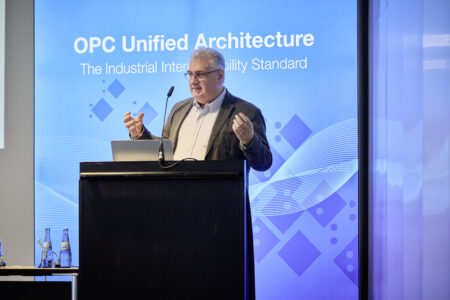The OPC Foundation, initiated by its member companies, is forming a new OPC UA for AI group, which is open to all its members. The group is chaired by Dr. Holger Kenn, Microsoft, who is also the Chairman of the OPC Foundation Board of Directors. He will lead this initiative to bridge the gap between automation systems and artificial intelligence (AI).
The OPC UA for AI group aims to address a critical question: How can OPC UA present information in a format that AI models can seamlessly utilize? The group will work on an answer to this question from different viewpoints:
AI in Engineering
AI serves as a powerful tool, especially in software development. While it cannot replace developers, it can make them more efficient by replacing manual searches from the device manuals, including quicker understanding of the provided information interfaces.
Domain-specific Documentation
AI can learn from PDFs, like device manuals or specifications. But in order to allow AI learning of the automation components or the processes, this information first needs to become available in a standardized description. Luckily this is what has already happened in many industries with the OPC UA Companion Specifications. By providing a mechanism for AI to learn these companion specifications, the domain knowledge becomes available to them, allowing to help software developers and project engineers to accomplish their tasks. This automates tedious tasks and increases the efficiency of the engineers.
Data Analysis and Retrieval
The data analysis typically involves collaboration between domain experts and programmers. By providing the data in a standardized format, thanks to OPC UA companion specifications, the very limited resource of domain experts is no longer needed for the data analysis.
End-Users Benefits
With all this standardized information available to AI, AI can provide answers to questions asked in human language. When responding to a question asked by an operator, AI can search through manuals, log reports, repair reports, etc., while looking at the live data of the device in order to provide a timely answer to the operator. In the past, all these activities would have been manual work, taking a serious amount of time from the limited resource of experts on site.
Also, Operators can then cooperate with machines via AI in their natural language, providing verbal instructions without the usage of operator panels or other traditional input devices. This speeds up the process of Human-Machine interaction and allows work to be finished faster.
The vision is clear: AI and OPC UA will collaborate seamlessly, enhancing automation systems and empowering humans through natural language interfaces. All of this is enabled by utilizing the domain specific information models and common information exchange standard OPC UA.
 Dr. Holger Kenn, Microsoft
Dr. Holger Kenn, Microsoft
“The potential applications of AI within manufacturing are vast, ranging from improving code efficiency to enhancing fault diagnosis,” says Dr. Holger Kenn, Chairperson OPC Foundation Board of Directors. “By collaborating within this working group, industry stakeholders can collectively drive innovation and unlock the full potential of AI within the OPC UA ecosystem.”
The OPC Foundation invites stakeholders from across the industrial automation landscape to join the working group and contribute to shaping the future of AI-enabled manufacturing solutions. The first kick off is planned shortly after summer break. Already 60+ experts have registered to join this new working group. If you want join the new formed working group “OPC UA for AI / AI for OPC UA”, please contact Karola.Wauro@opcfoundation.org.